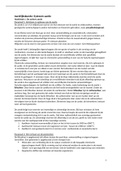Examen
ECN FINAL TEST QUESTIONS WITH 100% CORRECT ANSWERS
ECN FINAL TEST QUESTIONS WITH 100% CORRECT ANSWERS A firm is using 400 units of capital and 200 units of labor to produce 20,000 units of output. Capital costs $80 per unit and labor $20 per unit. The last unit of capital added 100 units of output, while the last unit of labor added 30 units of o...
[Montrer plus]












